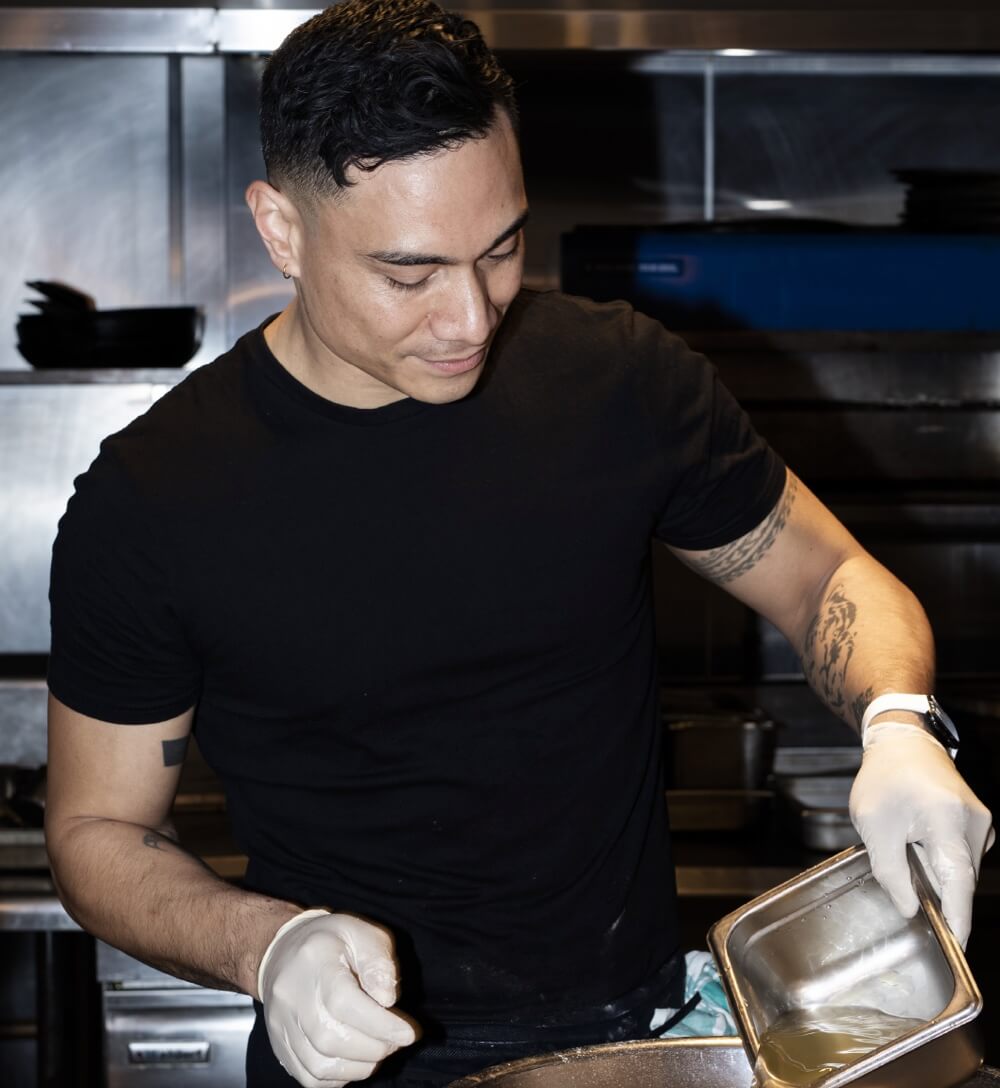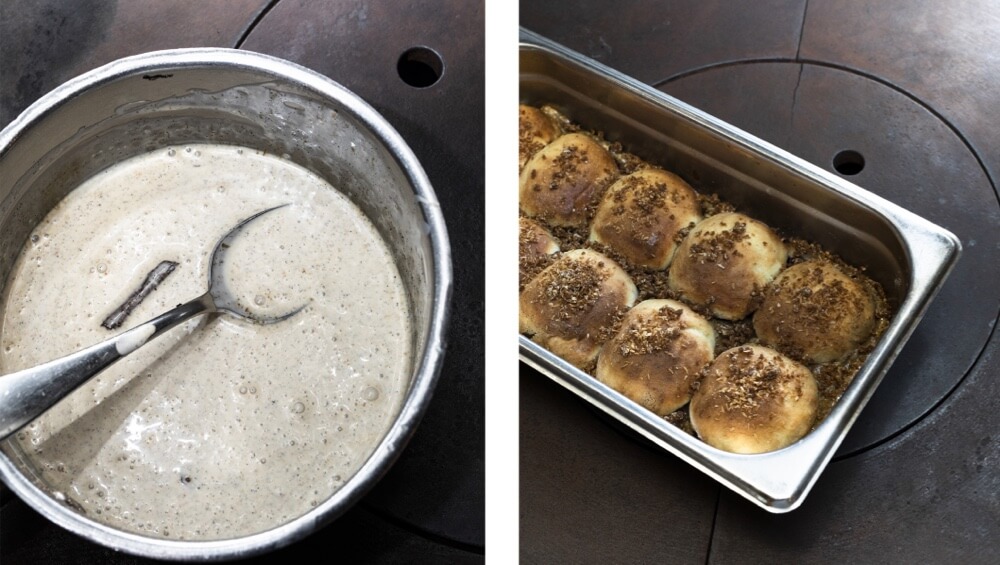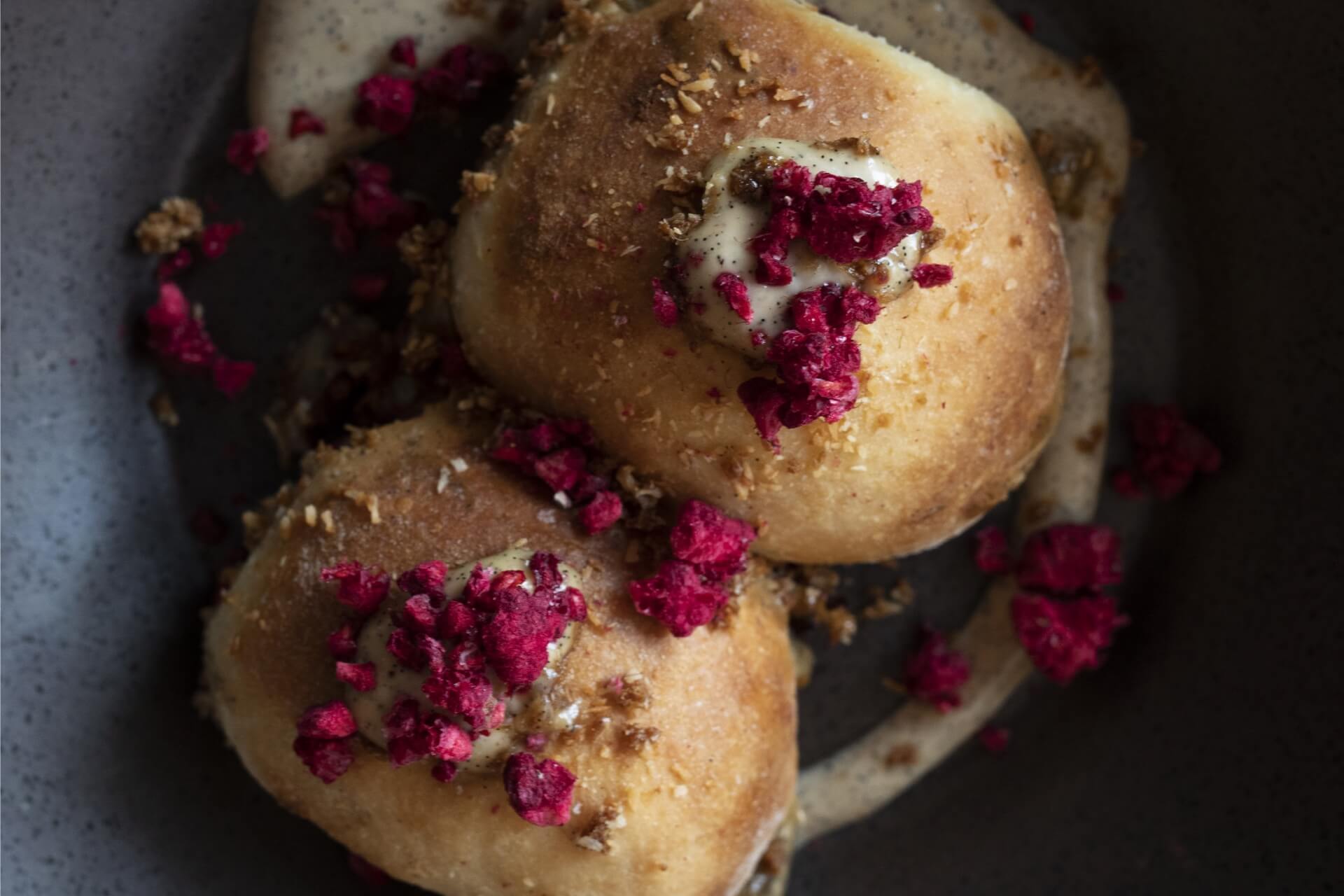Aug 10, 2021 Food
No one really knows where panipopo came from. “As with most histories, we’re making educated guesses, at best,” Garrett Hillyer, a doctoral candidate researching Pacific Islands history, emails me from overseas. “To your question of whether panipopo is inspired by German, Chinese or other influences, the answer is… yes.”
Bakeries of various cultural backgrounds were already operating in Sāmoa during the mid-to late-19th century, especially in areas like Apia and Pago Pago/Fagatogo, where many Sāmoans were living outside of the matai system (the traditional form of governance) and more open to cultural exchange with pālagi. Many were engaged with pālagi cultures, and some worked as cooks. Plus, a lot of the ingredients in panipopo — like yeast, flour, and sugar — entered Sāmoa as part of food-relief efforts following natural disasters. All of this likely contributed to panipopo’s fortunate existence: soft, sweet buns immersed in a tray of rich coconut sauce that, when either freshly whisked out of the oven or treated to a quick heat-up in a microwave, are so delicious they taste like home no matter what your background.
It makes sense, then, that a lot of panipopo is sold on Facebook Marketplace and other forms of social media, so have a browse there if you don’t mind taking a chance. (I often find Facebook Marketplace a delightfully unregulated zone of hidden gems.) However, if you’d rather go somewhere with a counter and a till, here are some places to eat panipopo in Tāmaki.
Whenever I’m in the area, I try to make a stop at Pinati’s Keke Pua’a in Ōtāhuhu, whose owner never fails to ask me where I’m from so she can proceed to excitedly tell me that her family, too, are part-Chinese, and what was my last name again? The German bun is my favourite, but today I’m here for the panipopo, which is written on the board in English as “coconut bun” and is, in fact, a little different from a “traditional” panipopo. The bun is filled with coconut cream instead of soaked in it and, well, is more doughnut than bun. It reminds me of parāoa parai, a deep-fried bread that’s puffed up, golden and fluffy, but slightly dense inside.
Bertrand Jang’s cafe and bakery, Sweet & Me, in Onehunga has a glass cabinet stocked to the brim with pretty cakes and desserts, such as pineapple pies and koko (cacao) lamingtons, that have roots all over the Pacific. You have to order their coconut buns in advance, which come in a tray of a dozen for $30. They smell amazing. Like most panipopo, Sweet & Me’s are brioche-based, soft and almost scone-like, with liberal crumbs that fall into my cupped hand and are then scooped straight back into my mouth. Claire, the baker, tells me the coconut sauce is a little different here; they use both coconut cream and milk, plus fine grated coconut, giving the buns layered flavours and a thicker texture. When I ask Salu, one of the women who work at Sweet & Me, where she goes for panipopo, she thinks for a bit and says, “It’s more something we make for each other.”
Moist Popo Buns are an Auckland company dealing in pre-mix panipopo, which they ship out to people all around the world craving a taste of Sāmoa. You get the dough mix, kneading flour, and Kara coconut cream (my personal brand of choice, too) and all the home baker has to do is add butter and water, wait for the dough to rise, and shape the buns into fat little spirals.
I’ve got to be honest with you: I screwed up somewhere along the way. Maybe it was the temperature of the water, or the way my useless, uncoordinated hands handled the dough. My efforts came out too goopy, with the flavour of the actual bun lacking (you really need it to soak up all the coconut cream and sugar sauce), and I think perhaps too much yeast was involved in the mix.
But I can see how it could satisfy someone’s longing for something familiar, and I wholeheartedly agree that panipopo needs to be consumed as quickly as possible when out of the oven, so the pre-mix concept is definitely a winner.
The best panipopo I ate for this story was from The Bitch Baker, run by a woman named Lei Timo, who bakes out of her house in Papatoetoe. All her food is vegan, and you have to order either via Instagram DM (@thebitchbaker) or email. Timo’s buns had perfect structure: dense enough to not fall apart once soaked in the light and watery coconut sauce, but still with an all-important fluffiness in the centre. The best part was that the bread itself was sweet, meaning the coconut had less heavy-lifting to do. The buns looked great, too: boulder-round and bronzed up top. I kept some in the fridge to microwave the day after, and they tasted so great I ate two for dinner.

Uelese (Wallace) Mua
Uelese (Wallace) Mua’s PANIPOPO
Uelese (Wallace) Mua is the new head chef at Euro, a restaurant that has recently undergone an upbeat make-over to try to help it shed its lingering white-man-business-lunch vibes to attract a younger, more casual crowd.
Mua had told me that coconut is one of his favourite ingredients, and that he was working to include his Sāmoan background in the dishes at Euro. Soon after, the new menu there had a dessert with rich, indulgent koko Sāmoa (cacao), and oka (raw fish) topping a dehydrated taro chip.
When I asked him to share panipopo with Metro readers, Mua’s mind started churning with ideas about how he could alter the traditional recipe with his own take. He tried using as much coconut flour as possible to introduce the flavour into the bread, but the more he added, the denser the buns got, so he took it out altogether. He experimented with caramelised coconut sugar and desiccated coconut at the bottom to counteract panipopo’s sogginess, and dehydrated raspberries also made an appearance. “It was one of my favourite things growing up,” Mua told me. His mum had her own recipe (some elements of which come through in this one) and, as a kid, he loved the extreme sweetness of the dish. Both his mum and sister would make the buns for him, using the same process, but they never turned out the same. There’s a lot of things that can go wrong, or make things turn out differently, he says — the water may be too hot; the environment you let the dough rest in may not be the right climate, either.
If you want to try other Sāmoan specialties, Mua recommends fa’apapa, which is a dense slab of coconut bread that his own son goes crazy for. “He smashes that,” he laughs.

Panipopo in progress
INGREDIENTS
Dough
— 500g plain flour
— 70g coconut Sugar
— 30g icing Sugar
— Pinch of salt
— 8g dry yeast
— 1 1⁄4 warm water
— 1 tsp honey
Coconut Sauce
— 300ml Coconut milk (Kara)
— 300ml Coconut cream (Kara)
— 2 tbsp caster sugar
— 1 vanilla pod
— 1 cinnamon quill
Toasted Coconut Crumb
— 1⁄2 cup desiccated coconut
— 2 tbsp coconut sugar
— Pinch of salt
— 20g freeze-dried raspberry
METHOD
1. Preheat the oven to 165 degrees.
2. Activate yeast with water and honey, then mix with dry ingredients.
3. Work into a dough, place in a bowl and cover with a damp towel or cling film to let prove in a warm place for 30 mins.
4. To prep the coconut sauce, heat all ingredients in a small pot till boil, then cool.
5. To prep the toasted coconut crumb, heat pan until medium heat, add coconut sugar and caramelise. Once caramelised, add dessicated coconut, salt, stir, followed by raspberries. Cool and set aside.
6. Work the dough with your hands and split into 10 pieces. Roll into mini buns and place in a baking tray on a bed of half the toasted coconut mix.
7. Cover with cling film and let prove a further 30 mins. 8. Pour coconut sauce over the buns and bake at 165 degrees for 20 mins. Once cooked, remove and top with the rest of the toasted coconut crumb.
Tip
To get a crispy top on buns, ensure to lather with coconut sauce whilst adding into the tray.
—
This piece was published in Metro 431 – Available here in print and pdf.






